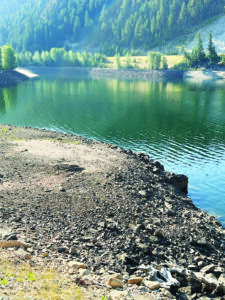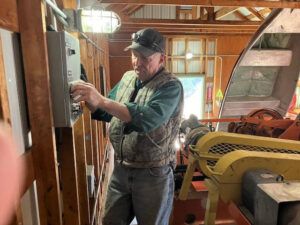
by John Dowd
Much of Montana’s recreation, agriculture and every day life is reliant on the water that runs through the veins of the state. The water in Montana’s rivers is often directly related to the snowpack it receives over the winter. With last winter’s snowpack at a record low, many Montanans have been feeling the hurt when it comes to the things they enjoy and that which keeps their livelihood growing.
According to J.R. Iman, the tender for the Painted Rocks Reservoir dam, they are already almost out of water, and will be by September 30. This year saw only about 65% of the normal snowmelt in the Bitterroot Valley. Iman added that this was one of the worst years in at least the last 20.
According to him, the reservoir has a 30-year running contract with local agriculture and the state, which allows for the dam to release 15,000 acre feet for Montana Fish and Wildlife, and around 10,000 acre feet for agriculture in the valley.

This contract is unique and the first of its kind in the state. The program was started to address the fact that Montana’s snowpack can vary so much from year to year. With so much reliance on the snow, locals in the Bitterroot wanted to create a safeguard against bad years. The contract is so effective that it is often used in other places in the state as an example. The contract lays out specific parameters for how the dam can be operated and how water must be conserved. The symbiotic relationship with all parties involved means even in a bad year, like this one, “everybody hurts, but nobody starves,” said Iman.
The dam will begin shut down operations for the year about two weeks early this year. They will start shutting down between September 12 or 15, and plan to be shut down within a week and a half. The process will be slow, as they can only release so much at a time to prevent shocking the fish. Once the reductions start, each adjustment will be around 50 cubic feet per second (cfs), and changes will occur every three days until the outflows match the inflows. They will release about 300 cfs into the river for the next 10 days. So far, they only have about 8,000 acre feet left to deliver.
The goal has always been to extend the normal season by about 30 to 40 days. That includes both the agricultural season as well as the recreational season. According to Iman, they were able to accomplish this and then some this year, reaching far beyond what was predicted early in the year.
In the end, the dam will always need to keep about 7,000 acre feet of water to maintain 15 to 20 feet above the intakes, which are all original. The reservoir holds around 32,000 acre feet in total and draws from a drainage that covers over 50 square miles. In a season of regular snowmelt, the reservoir could be filled five times over. However, it can only catch enough to fill once. The rest of the water flows over the top and down into the system.
The water from Painted Rocks Reservoir flows down the West Fork of the Bitterroot before combining with the East Fork to form the main stem of the river about four miles south of Darby. The water is measured at the dam when it leaves. Within eight hours, about 80% of the water will reach Darby, where it is measured again. The water will then be measured at Bell Crossing, where Iman says about 50% will reach. The major users are between those points, closer to Hamilton. All these users have head gates that allow the water to flow in and irrigate their land.
These users all have water rights to the river, some going back as far as 1865, and as recent as 1905, and the river is not their only water right. “The water they buy helps the whole system,” said Iman. The users are all members of the Painted Rock Water Users Association. This is the group that purchases the 10,000 acre feet from the dam, and all users pay a fixed rate.
The money from the association and state FWP purchase goes to the DNRC to cover maintenance, operation and a fund saved in the case the dam needs future repairs. With the dam completely original, and having been built in 1938, this fund helps assure the dam can continue operation. Because of the water the users and the state pay for, “everybody gets enough to get by,” though maybe not everything they want, said Iman. He added that it is only meant to “supplement river flow” throughout the season, allowing everyone to benefit. With current water rights, the water users could legally pull all the water from the river. However, the contract allows them to supplement their fields while the river continues to flow for everyone, including the fish. The agreement safeguards a few extra weeks.
When looking over the last year, and on to future years, Iman commented that this year reminds everyone why it is “extremely important that we are careful with use early on in the season.” Going into the fall, Iman said, fortunately, “The ag season is pretty much over.” As for the fish, “Hopefully cooler weather and fall storms supplement the flow.”
Hobo Hilton says
Every day “Mother Nature” speaks to us. Unfortunate the politicians and so called “Leaders” don’t understand. It does not take a rocket scientist to see what is happening in the Western United States. The day will come when the west will be nothing more than a dust bowl.